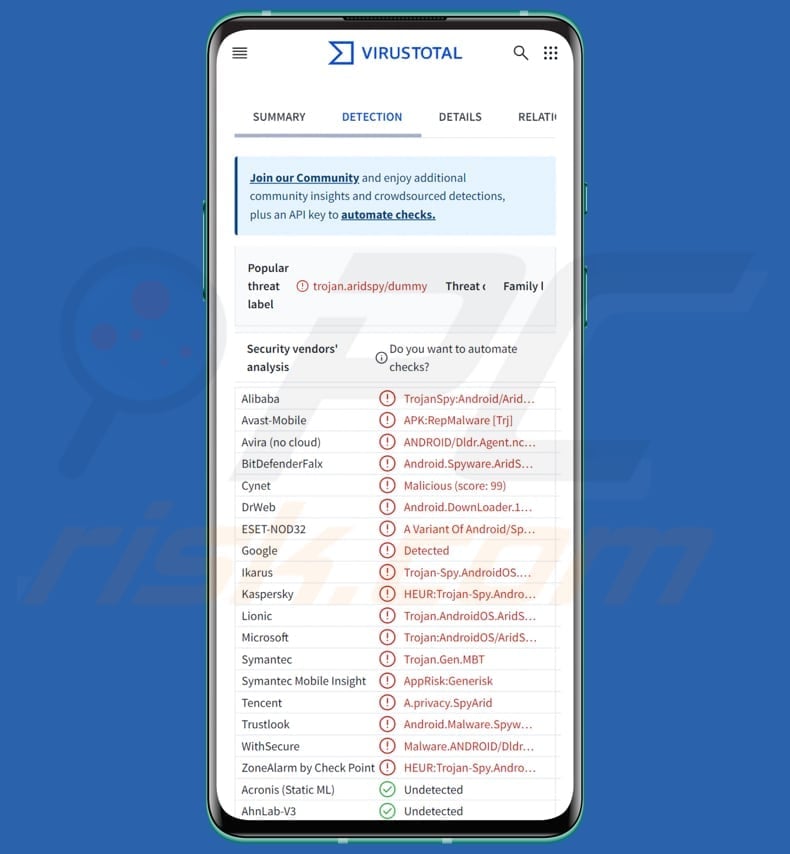Get free scan and check if your device is infected.
Remove it nowTo use full-featured product, you have to purchase a license for Combo Cleaner. Seven days free trial available. Combo Cleaner is owned and operated by RCS LT, the parent company of PCRisk.com.
What is AridSpy?
AridSpy is a piece of malware (a trojan) targeting Android users. Cybercriminals deliver AridSpy via trojanized applications that contain a malicious code. This malware is used to steal various information from the infected Android devices. AridSpy should be eliminated from infected devices as soon as possible.

AridSpy in detail
After a trojanized app with AridSpy is installed, the malware checks the presence of specific security tools on the operating system and sends this information to the command and control (C2) server. If the malware finds that none of the security tools from its list are installed, it downloads the first-stage payload.
The initial payload pretends to be an update for Google Play services. When users install this malicious update, it masquerades under names like Play Manager or Service Google. This payload operates independently and does not require the trojanized app to be present on the same device.
The first-stage payload's role is to download the second-stage payload, which is a Dalvik executable. The second-stage payload contains the malicious functionality, specifically designed for data exfiltration.
AridSpy can harvest a wide range of data, such as call logs, contact lists, text messages, device location, WhatsApp databases, clipboard data, received notifications, Facebook Messenger and WhatsApp communications, bookmarks (and search history) from several browsers, and files with certain extensions stored in the external storage.
Moreover, the malware record phone calls, take photos, record audio via the microphone, and perform keylogging by capturing all text visible and editable in any installed app.
| Name | AridSpy Trojan |
| Threat Type | Android malware, malicious application, Trojan |
| Detection Names | Avast-Mobile (APK:RepMalware [Trj]), Combo Cleaner (Android.Spyware.AridSpy.A), ESET-NOD32 (A Variant Of Android/Spy.AridSpy.A), Kaspersky (HEUR:Trojan-Spy.AndroidOS.Dummy.c), Full List (VirusTotal) |
| Symptoms | The device is running slow, system settings are modified without user's permission, questionable applications appear, data and battery usage is increased significantly, browsers redirect to questionable websites, intrusive advertisements are delivered. |
| Distribution methods | Trojanized apps, third-party app stores, deceptive websites |
| Damage | Stolen personal information (private messages, logins/passwords, etc.), decreased device performance, battery is drained quickly, decreased Internet speed, huge data losses, monetary losses, stolen identity. |
| Malware Removal (Windows) |
To eliminate possible malware infections, scan your computer with legitimate antivirus software. Our security researchers recommend using Combo Cleaner. Download Combo CleanerTo use full-featured product, you have to purchase a license for Combo Cleaner. 7 days free trial available. Combo Cleaner is owned and operated by RCS LT, the parent company of PCRisk.com. |
Possible damage
The extensive capabilities of AridSpy malware can lead to severe negative consequences for victims. This might include identity theft and financial fraud. The stolen data can be used to impersonate victims or gain unauthorized access to their accounts and financial information. Also, victims may suffer financial losses.
Furthermore, victims may have their private conversations and activities monitored without their knowledge and consent, leading to privacy breaches. Overall, the capabilities of AridSpy pose serious risks and potential harm to victims.
How did AridSpy infiltrate my device?
AridSpy is distributed through trojanized versions of legitimate apps, such as LapizaChat, NortirChat, and ReblyChat. These apps mimic real programs like StealthChat, Session, and Voxer Walkie Talkie Messenger, falsely claiming to offer secure chat services.
In addition, the malware is also spread through apps posing as the Palestinian Civil Registry and a job opportunity app, neither of which are trojanized versions of existing legitimate apps. Devices become infected upon downloading and installing malicious apps via third-party websites or app stores.
How to avoid installation of malware?
Download applications from official sources (official pages and app stores). Avoid downloading from other sources to avoid downloading malicious or other unwanted apps. Also, read reviews and check ratings before installing any applications. Do not open links in suspicious emails or messages from unknown addresses or numbers.
Avoid interacting with pop-ups, ads, buttons, and similar content displayed on shady sites. Regularly scan your devices for unwanted apps and remove detected threats. Also, keep all apps and the operating system up to date.
Screenshot of the trojanized apps (NortirChat, ReblyChat, LapizaChat) containing AridSpy - source: welivesecurity[.]com:

Other examples of apps used to deliver AridSpy - source: welivesecurity[.]com:

Screenshot of AridSpy requesting to download the first-stage payload - source: welivesecurity[.]com:

Quick menu:
- Introduction
- How to delete browsing history from the Chrome web browser?
- How to disable browser notifications in the Chrome web browser?
- How to reset the Chrome web browser?
- How to delete browsing history from the Firefox web browser?
- How to disable browser notifications in the Firefox web browser?
- How to reset the Firefox web browser?
- How to uninstall potentially unwanted and/or malicious applications?
- How to boot the Android device in "Safe Mode"?
- How to check the battery usage of various applications?
- How to check the data usage of various applications?
- How to install the latest software updates?
- How to reset the system to its default state?
- How to disable applications that have administrator privileges?
Delete browsing history from the Chrome web browser:

Tap the "Menu" button (three dots on the right-upper corner of the screen) and select "History" in the opened dropdown menu.

Tap "Clear browsing data", select "ADVANCED" tab, choose the time range and data types you want to delete and tap "Clear data".
Disable browser notifications in the Chrome web browser:

Tap the "Menu" button (three dots on the right-upper corner of the screen) and select "Settings" in the opened dropdown menu.

Scroll down until you see "Site settings" option and tap it. Scroll down until you see "Notifications" option and tap it.

Find the websites that deliver browser notifications, tap on them and click "Clear & reset". This will remove permissions granted for these websites to deliver notifications. However, once you visit the same site again, it may ask for a permission again. You can choose whether to give these permissions or not (if you choose to decline the website will go to "Blocked" section and will no longer ask you for the permission).
Reset the Chrome web browser:

Go to "Settings", scroll down until you see "Apps" and tap it.

Scroll down until you find "Chrome" application, select it and tap "Storage" option.

Tap "MANAGE STORAGE", then "CLEAR ALL DATA" and confirm the action by taping "OK". Note that resetting the browser will eliminate all data stored within. This means that all saved logins/passwords, browsing history, non-default settings and other data will be deleted. You will also have to re-login into all websites as well.
Delete browsing history from the Firefox web browser:

Tap the "Menu" button (three dots on the right-upper corner of the screen) and select "History" in the opened dropdown menu.

Scroll down until you see "Clear private data" and tap it. Select data types you want to remove and tap "CLEAR DATA".
Disable browser notifications in the Firefox web browser:

Visit the website that is delivering browser notifications, tap the icon displayed on the left of URL bar (the icon will not necessarily be a "Lock") and select "Edit Site Settings".

In the opened pop-up opt-in the "Notifications" option and tap "CLEAR".
Reset the Firefox web browser:

Go to "Settings", scroll down until you see "Apps" and tap it.

Scroll down until you find "Firefox" application, select it and tap "Storage" option.

Tap "CLEAR DATA" and confirm the action by taping "DELETE". Note that resetting the browser will eliminate all data stored within. This means that all saved logins/passwords, browsing history, non-default settings and other data will be deleted. You will also have to re-login into all websites as well.
Uninstall potentially unwanted and/or malicious applications:

Go to "Settings", scroll down until you see "Apps" and tap it.

Scroll down until you see a potentially unwanted and/or malicious application, select it and tap "Uninstall". If, for some reason, you are unable to remove the selected app (e.g., you are prompted with an error message), you should try using the "Safe Mode".
Boot the Android device in "Safe Mode":
The "Safe Mode" in Android operating system temporarily disables all third-party applications from running. Using this mode is a good way to diagnose and solve various issues (e.g., remove malicious applications that prevent users you from doing so when the device is running "normally").

Push the "Power" button and hold it until you see the "Power off" screen. Tap the "Power off" icon and hold it. After a few seconds the "Safe Mode" option will appear and you'll be able run it by restarting the device.
Check the battery usage of various applications:

Go to "Settings", scroll down until you see "Device maintenance" and tap it.

Tap "Battery" and check the usage of each application. Legitimate/genuine applications are designed to use as low energy as possible in order to provide the best user experience and to save power. Therefore, high battery usage may indicate that the application is malicious.
Check the data usage of various applications:

Go to "Settings", scroll down until you see "Connections" and tap it.

Scroll down until you see "Data usage" and select this option. As with battery, legitimate/genuine applications are designed to minimize data usage as much as possible. This means that huge data usage may indicate presence of malicious application. Note that some malicious applications might be designed to operate when the device is connected to wireless network only. For this reason, you should check both Mobile and Wi-Fi data usage.

If you find an application that uses a lot of data even though you never use it, then we strongly advise you to uninstall it as soon as possible.
Install the latest software updates:
Keeping the software up-to-date is a good practice when it comes to device safety. The device manufacturers are continually releasing various security patches and Android updates in order to fix errors and bugs that can be abused by cyber criminals. An outdated system is way more vulnerable, which is why you should always be sure that your device's software is up-to-date.

Go to "Settings", scroll down until you see "Software update" and tap it.

Tap "Download updates manually" and check if there are any updates available. If so, install them immediately. We also recommend to enable the "Download updates automatically" option - it will enable the system to notify you once an update is released and/or install it automatically.
Reset the system to its default state:
Performing a "Factory Reset" is a good way to remove all unwanted applications, restore system's settings to default and clean the device in general. However, you must keep in mind that all data within the device will be deleted, including photos, video/audio files, phone numbers (stored within the device, not the SIM card), SMS messages, and so forth. In other words, the device will be restored to its primal state.
You can also restore the basic system settings and/or simply network settings as well.

Go to "Settings", scroll down until you see "About phone" and tap it.

Scroll down until you see "Reset" and tap it. Now choose the action you want to perform:
"Reset settings" - restore all system settings to default;
"Reset network settings" - restore all network-related settings to default;
"Factory data reset" - reset the entire system and completely delete all stored data;
Disable applications that have administrator privileges:
If a malicious application gets administrator-level privileges it can seriously damage the system. To keep the device as safe as possible you should always check what apps have such privileges and disable the ones that shouldn't.

Go to "Settings", scroll down until you see "Lock screen and security" and tap it.

Scroll down until you see "Other security settings", tap it and then tap "Device admin apps".

Identify applications that should not have administrator privileges, tap them and then tap "DEACTIVATE".
Frequently Asked Questions (FAQ)
My device is infected with AridSpy malware, should I format my storage device to get rid of it?
Formatting your storage device will effectively remove AridSpy malware from your device. However, it will also remove all data. It is recommended to scan the infected device with a reputable security tool like Combo Cleaner to see if AridSpy can be detected and eliminated without formatting the storage device.
What are the biggest issues that malware can cause?
Malware can cause significant issues such as data theft, identity theft, financial loss, and additional infections. It can also disrupt normal device operations and compromise system stability.
What is the purpose of AridSpy?
The purpose of AridSpy is to gather sensitive data and conduct surveillance on infected devices.
How did AridSpy infiltrate my device?
AridSpy typically infiltrates devices through trojanized apps masquerading as legitimate software or through deceptive downloads and installations.
Will Combo Cleaner protect me from malware?
Combo Cleaner can effectively detect and remove almost all known malware. Sophisticated malware often conceals itself deeply within the system. Therefore, performing a full system scan is essential to ensure complete detection and removal.
Share:

Tomas Meskauskas
Expert security researcher, professional malware analyst
I am passionate about computer security and technology. I have an experience of over 10 years working in various companies related to computer technical issue solving and Internet security. I have been working as an author and editor for pcrisk.com since 2010. Follow me on Twitter and LinkedIn to stay informed about the latest online security threats.
PCrisk security portal is brought by a company RCS LT.
Joined forces of security researchers help educate computer users about the latest online security threats. More information about the company RCS LT.
Our malware removal guides are free. However, if you want to support us you can send us a donation.
DonatePCrisk security portal is brought by a company RCS LT.
Joined forces of security researchers help educate computer users about the latest online security threats. More information about the company RCS LT.
Our malware removal guides are free. However, if you want to support us you can send us a donation.
Donate
▼ Show Discussion